This September and October, we’re taking a look at the jam-packed 1994 to 1995 season of Star Trek, including Star Trek: Deep Space Nine and Star Trek: Voyager. Check back daily for the latest review.
Heart of Stone feels quite similar to Life Support. Once again, there’s a main plot that doesn’t involve Kira quite as much as it should. Once again, this is supplemented by a subplot involving Quark’s mischievous nephew, Nog. And yet – while still flawed in a number of ways – Heart of Stone works a lot better than Life Support did, primarily because it’s a lot more thoughtfully constructed. The lack of focus on Kira is explained as part of the plot; Nog isn’t holding down an unfunny comedy subplot, he’s getting some nice character development.
Heart of Stone is occasionally a little heavy-handed in its character beats, but it works well because it pitches its plot at the right level, focusing on the characters at the heart of these stories.
To be fair, it is a bit weird to have a plot that involves Kira so heavily (even as a supporting character) directly following the events of Life Support. Kira just lost her lover, who she had been dating for over a year. The last episode ended with her keeping a quiet vigil over his dying corpse, crying over how much she loved him. Indeed, Life Support was weird in how firmly it marginalised Kira while telling a story in which her boyfriend died. Kira wound up sharing focus with Bashir and Winn.
For all the credit that Deep Space Nine gets as a serialised space opera, it wasn’t quite there yet. So it wouldn’t be unreasonable if the issue were dropped and pushed to one side. It wouldn’t be the worst thing in the world if Kira was a background character for a few episodes so that the audience would forget about Bareil by the next time the show decided to do a Kira-centric episode. We could assume that Kira had – to quote Life Signs – grieved “in [her] own way, in [her] own time.”
Unfortunately, it seems like an unfortunate quirk of scheduling that Heart of Stone is scheduled directly following Life Support. Both are stories involving Kira where Kira is a secondary character involved primarily as a love interest. The scheduling of Life Support makes it seem like the writers were just waiting to kill off Bareil so that they could start teasing the idea of Odo pairing up with Kira.
This problem is somewhat compounded by the fact that Kira’s next story (and the only Kira-centric story before the end of the season) exists to introduce another weirdly stoic father-figure future love interest for the character. Still, even without any of this subtext, the opening scene of the episode is still disconcerting juxtaposed with the closing scene of the previous episode. It feels strange to go from Kira crying over her lover’s body to Kira joking playfully with Odo and dealing with his wounded ego.
Still, Heart of Stone isn’t really about Kira. It’s about Odo’s infatuation with Kira, something that the show has been building towards since at least Necessary Evil, and expressly confirmed in Fascination. It’s a classic unrequited crush, the type of love story that television loves; there’s a nerdy and introspective male lead who is close friends with a beautiful and charming young woman. He idolises her. She likes him as a friend, but she doesn’t realise that he is attracted to her. It’s a stock romantic cliché.
However, it’s also a somewhat problematic archetype, primarily because using it as a storytelling tool typically reduces the object of the character’s affection into an object to be won. The object of our unrequited romantic’s affection typically becomes a trophy robbed of her own agency. The audience is asked to wonder when she will eventually come to her senses and appreciate her platonic friend who has secretly loved her for all these years. It’s the kind of thing that John Hughes did so well.
And, if there’s one problem with the relationship between Odo and Kira, it’s that Kira never really has any agency. We see why Odo is in love with Kira, we follow him agonising about bottling all that up inside, but we never really see Kira coming to terms with it. It’s not even a “what does Kira see in Odo?” question – obviously there’s a lot to love about Odo. The problem is that the show never seems too bothered with how Kira switches from “he’s a great friend” to “he’s a person I love romantically.”
This plays out across the run of Deep Space Nine. Even the aftermath of Children of Time, the episode where Kira inevitably discovers Odo’s crush, her agency is glossed over. She is horrified by what Odo would do in her name, but she gets over that off-screen. In A Call to Arms, they put the discussion of it on hold at Odo’s request and it doesn’t really come back up until he works up the courage to pursue her in His Way. Even during Behind the Lines, her sense of betrayal at Odo’s conduct is strictly one of a friend.
And, to be fair, some of this makes sense. Kira is a character who internalises a great deal. Her gestures of affection towards Odo tend to be more pragmatic than romantic – as demonstrated in episodes like Chimera. Kira clearly cares for Odo a great deal, she just doesn’t externalise the process as much. This makes sense for Kira. She’s a character who doesn’t generally like to talk about personal stuff. She carries a lot of emotional baggage, but she carries it stoically and quietly.
It is worth noting that this makes Odo is the more emotive of the pair. He is the one who is prone to big romantic gestures and emotional dependence. This makes for a nice inversion of the traditional dynamic between male and female romantic leads. So the relationship between Odo and Kira is not completely problematic – in many respects, it’s quite a clever play on traditional gender roles and expectations. It is quite a fascinating and multi-faceted relationship. Unfortunately, it happens that some of those facets are a little uncomfortable.
So it’s a balancing act. Heart of Stone has some interesting stuff to say, but there are also some awkward plot beats. Most obviously, Heart of Stone features Kira locked in a stasis unit while she serves a tool through which the Founders can emotionally manipulate Odo. In short, she is – literally and figuratively – a woman in a refrigerator. It feels like a very cynical use of a character who has been of the show’s strongest and most interesting protagonists. Again, there’s a sense that we’re only interested in how Odo feels about Kira, which will become a recurring problem in the dynamic.
Still, once you get past that hurdle, Heart of Stone is quite fascinating. Indeed, Ira Steven Behr and Robert Hewitt Wolfe seem to have constructed Heart of Stone as a deconstruction of the traditional unrequited love story, which gives the story a bit of bite that it would not otherwise have. The episode is very clearly building towards Odo’s declaration of love for Kira. He’s normally so stoic and reserved, but the situation forces his hand. He finally utters those painful words, as the situation looks incredibly grim. It looks like agony for Odo to articulate what he’s kept bottled up for so long.
And then she replies, without hesitation, “Odo, I’m in love with you too.” It’s a classic romantic story beat. Our heroes are in an inescapable situation; given the freedom to finally say what is on their minds, knowing they won’t have to face the repercussions. However, they inevitably discover that the object of their affection has always felt the same way. Buoyed by this revelation, our heroes manage to escape against all odds and ride off together into the sunset a life of blissful togetherness.
At least, that’s how the story’s supposed to go. That’s what we’re conditioned to expect. That’s how these sorts of romances always play out. And we want to believe it, just like Odo wants to believe it. One of the best things about Heart of Stone is the structure. Kira’s reciprocal declaration is used as an act break. We get a scene of the episode’s subplot before jumping back into the resolution. There’s a long dramatic pause – a moment where we almost believe it; a moment where Odo almost believed it.
There’s a delightful ambiguity there. Did Odo believe it? He must have wanted to accept Kira’s declaration. The gap in the episode’s chronology leaves it open to the viewer. Did Odo immediately figure out something was amiss, or did it take a moment? Did he allow himself a few seconds to savour those words, to enjoy the comforting lie? Or was his reaction purely cold and logical, shuffling his emotions aside? It’s something that’s fun to think about, underscored by Auberjonois’ amazing performance.
However, Odo is too smart to buy into that lie – as nice as it would be to believe. Odo is too smart to get sucked into the fairytale. He picks apart the story, recognising that the scenarios doesn’t feel true. He spots the clichés, the narrative shortcuts, the logical leaps. “This whole situation hasn’t seemed right since the beginning,” he offers, critiquing the script. “There’ve been too many coincidences, too many unanswered questions.” He’s right: Kira’s distress call comes too soon after she parts company with him; the Maquis is a narrative loose end; this random isolated spot is too isolated to be random.
All that’s missing is a scene where Odo cracks open the absurd monstrosity the props department have trapped Nana Visitor inside, which the actress herself described as “an awful choice.” However, the obvious fakeness of the rock “thing” seems quite ingenious in hindsight. It is a dodgy prop in a cliché drama that Odo peers through. This isn’t a story about a lonely nerd who happens to get the girl he has been pining for after all these years; this is a story about a lonely nerd seeing through that story.
The script calls attention to its fictitious nature. Odo even tries to use some of the familiar clichés to his advantage. When Kira is trapped, he assures her, “We’ve been in worse situations than this one and come out all right.” Kira sees through it as a comforting lie. Odo explains, “In the detective novels Chief O’Brien gives me to read, when the hero says, we’ve been in tougher situations than this one, his friends always agree.” Odo is trying to invoke that cliché, to make it work to his advantage. However, he’s confronted by the fact that the world doesn’t work on stock clichés.
Playing into that sense of self-awareness, the episode is knows how the audience watches television. It’s wary of an obvious spoiler that would be given away by the form. Guest star Salome Jens has her credit bumped to the end credit in order to preserve the reveal – with Behr and Wolfe aware that fans would instantly recognise her name and deduce her involvement in the plot. It’s a nice bit of work – akin to decision to keep the wormhole out of the credits for Emissary. (It’s worth noting that the credits to Caretaker made no such efforts to preserve any mystery.)
Even after the Female Changeling reveals herself, Odo is still pulling at threads. He points out the various plot holes, the leaps in logic necessary to accept the narrative as presented. “How did you get your hands on a Maquis ship?” Odo wonders, pre-empting a few dozen nerdy reviewers. The Female Changeling recognises that Odo’s really asking the wrong questions, and argues that the writers can’t explain absolutely everything. “Now, Odo, you really can’t expect me to give you all the answers.”
Of course, all of this playfully self-aware meta-fictional stuff is undermined somewhat by the fact that acknowledging Odo’s attraction to Kira effectively mandates that the show will have to follow through on Odo’s attraction to Kira at some point down the line. Odo’s infatuation is now Chekov’s gun. It has been placed firmly on the mantle, so it will have to go off at some point in the next four years.
Had Heart of Stone been the end of the matter, it would be a much more interesting episode – with the rest of the show standing testament to Odo’s devastatingly self-aware demolition of Kira’s response to his admission of affection. Odo and Kira would have remained friends for the rest of the show’s run, and Odo would have respected that because the friendship means so much to him. Unfortunately, doing an episode like this essentially commits to doing an episode like His Way.
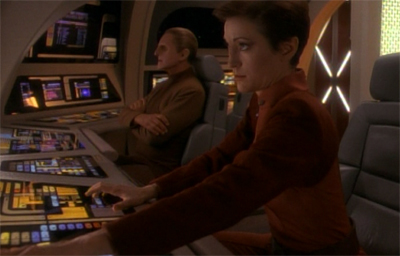
If Odo had been wrong and it had really been Kira, that would have been the most awkward runabout ride home ever…
Still, even with all this baggage (which the episode navigates well), Rene Auberjonois is absolutely fantastic. He remains one of the stand out performers in a phenomenal ensemble. He conveys so much, so effectively, and with so much nuance. The scene where he picks apart Kira’s declaration of love is so devastating because it’s clear that Odo has been carefully and meticulously framing it so that he can deliver it as stoicly as popular. There’s an incredible amount of emotion there, all bottled up so tight.
While the subplot between Odo and Kira is a fantastic execution of a somewhat troublesome concept, the episode’s Nog subplot works even better. It is just as tightly-structured and cleverly constructed as the main plot line, but without any of the baggage. It’s also a logical pay-off to story threads that have been building for the past few years. It continues Behr’s development of the Ferengi into more than just comedic foils.
The opening scene with Sisko and Nog demonstrates how far the Ferengi have come. It’s played beautifully. Sisko began Deep Space Nine very wary of the Ferengi – distrustful of the species, based on Federation propaganda and Starfleet policy. In the years since, his views have developed and grown. When Nog arrives, he is a little wary, but he’s also very friendly. He smiles and awkwardly shakes hands with Nog. There’s no sense of Sisko being unnecessarily suspicious. He seems more bemused by what is going on.
Indeed, when Nog tells him that he recently underwent a Ferengi ritual, Sisko seems genuinely happy for him. “Congratulations,” he smiles. When Nog presents him with a bundle full of latinum, Sisko doesn’t jump to conclusions – he doesn’t accuse Nog of attempted bribery or anything as obscene. “What is this?” he asks, politely; he’s curious, as if appreciating that this might be a cultural custom important to Nog. In the end, when Nog explains that it’s a Ferengi tradition, Sisko even accepts the latinum (albeit temporarily), a sign of how far he’s come and how tolerant he has become.
There are still limits. Sisko does get a little tetchy and suspicious when Nog states that he wants to go to Starfleet Academy. There’s a sense that perhaps a little of Sisko’s prejudice remains, although it’s not entirely unjustifiable in Nog’s case – Nog is a repeat juvenile offender, a misogynist and somebody who has never expressed an interest in Starfleet before. Coupled with Sisko’s occasionally fanatic defence of the Starfleet uniform as an institution, it makes sense as a character beat.
However, the real beauty of the Heart of Stone subplot is that it makes perfect sense from a character point of view. Everybody’s motivations are perfectly understandable. Nobody is acting out of character. More than that, the subplot is structured beautifully. The crew spend the bulk of the episode trying to figure out why Nog might want to join Starfleet. The answer is presented in the first scene set in the bar – we get to see Quark humiliating and ignoring Rom, as Nog tries to stand up for his bumbling father. That’s the perfect motivation, it fits with what we’ve seen of Quark and Rom, and it’s completely understandable.
However, Behr and Wolfe are very clever here. They structure that scene so that it is effectively a preamble to another scene. It happens before Jake arrives in the bar, and starts talking about the “pretty funny joke” that Nog pulled. The focus of the scene shifts to explain that Nog really wants this, and so the assumption is that the audience will write off the preamble with Rom and Quark as background material – a nice attempt to bring the station to life and add context, rather than the answer to the mystery that everybody else is trying to solve.
And again, like the subplot with Odo and Kira, it all builds to a pretty phenomenal character moment. Aron Eisenberg isn’t quite the phenomenal actor that Auberjonois is, but the monologue is pretty fantastic. Like Odo’s unrequited love, there’s a sense that Nog’s dissatisfaction with the life laid out for him is universally relevant. He might be buried under mountains of makeup, but he feels like a real character with real problems. It’s an absolutely beautiful moment that almost justifies every awkward misuse of the character over the last three years. (And makes his involvement in Life Support all the more surreal.)
Heart of Stone isn’t a fantastic episode, but it’s a solidly constructed episode with some fantastic moments. It’s an example of how superb character work can carry an episode like this. Sure, the way that it develops the relationship between Odo and Kira will eventually become problematic and it reduces Kira to a glorified prop, but – in isolation – it’s a brutal deconstruction of the unrequited love narrative, anchored in an amazing central performance from Rene Auberjonois.
You might be interested in our reviews of the third season of Star Trek: Deep Space Nine:
- The Search, Part I
- The Search, Part II
- House of Quark
- Equilibrium
- Second Skin
- Supplemental: Fearful Symmetry by Olivia Woods
- The Abandoned
- Civil Defense
- Meridian
- Defiant
- Supplemental: (Malibu Comics) #29-30 – Sole Asylum
- Fascination
- Past Tense, Part I
- Past Tense, Part II
- Life Support
- Heart of Stone
- Supplemental: (Malibu Comics) The Rules of Diplomacy
Filed under: Deep Space Nine | Tagged: change of heart, deep space nine, Dominion, female changeling, heart of stone, Kira, nog, Odo, star trek, star trek: deep space nine, Starfleet, unrequited love |















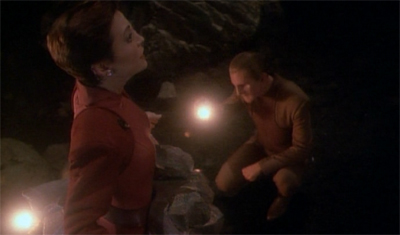




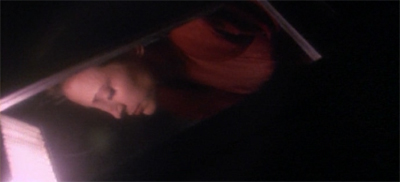

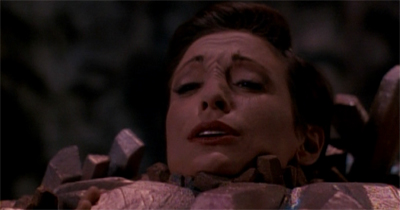
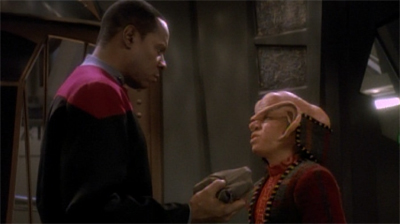
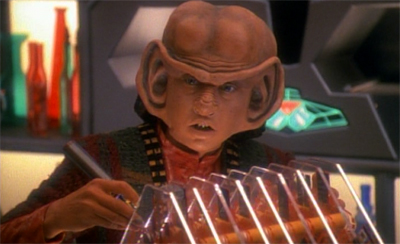

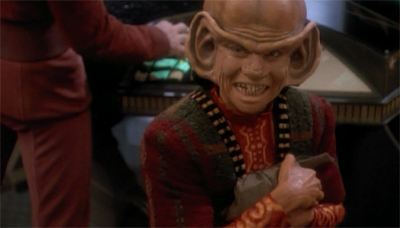
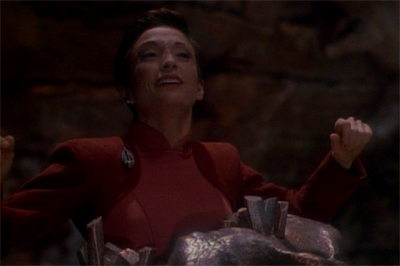







Great write up. Rene Auberjonois is fantastic in this episode – I always cringe whenever Odo is forced to display any emotion – he’s so bad at it – and you really feel his pain in this episode.
With the whole Rom joining Starfleet arc, I did feel echoes of Wesley Crusher, but the writers kept it much more Rom-specific. I also agree that the “stone” prop was horrendous, lol
Auberjonois is massively underrated. But then, so is most of the DS9 ensemble. Terry Farrell was probably the weakest member of the ensemble, but she’s still stronger than Wheaton, Sirtis, Wang or Montegomery, to pick some random examples.
Riding off into the sunset for a life of blissful togetherness, just like Daphne and Niles in Frasier? Hmmm. Was DS9 one of the first shows to keep a character hidden away until the end credits? Another example that springs to mind is the Angel episode The Trial when Drusilla shows up unexpectedly at the end to sire Darla. Federation propaganda about the Ferengi, like in Caretaker where Harry Kim was warned about them at the Academy. Although Quark was trying to scam Harry, I felt his indignation was not altogether uncalled for.
The b-plot in Heart of Stone is shockingly affecting, considering it consists of a small orange troll (your term for the Ferengi-not mine https://them0vieblog.com/2016/10/03/star-trek-deep-space-nine-let-he-who-is-without-sin/. By the way, it’s completely apt and hilarious) begging a man in silly pajamas to let him into an organization so that he too, one day, can wear those same pajamas.
But it taps into something real, how people often feel trapped by their origins, unable to transcend their roots. Deep Space Nine chooses to send the message that, well, people can-but it’s difficult. It’s yet another example of Deep Space Nine rejecting cheap cynicism in favor of an earned optimism.
The A-plot was fine.
I much prefer the b-plot to the a-plot, even if the a-plot (like a lot of the third season) feels like a dress rehearsal for the kind of storytelling that Deep Space Nine would employ on a regular basis later in its run.
It’s a two-hander, which DS9 certainly knows how to do well, spectacularly, even. For some reason though, it doesn’t really click here-not much intrigue or depth to it. And the terrible cave set doesn’t help (Waltz got around it with great writing though).
Yep. As with a lot of the third season, I think that there’s a sense of doing dress rehearsal for the stuff that later seasons would do much better. (For some reason, I always think of Change of Heart as a companion piece to this, likely due to the shared couple-on-a-mission-and-a-character-subplot-with-“Heart”-in-the-title-ness of it all.